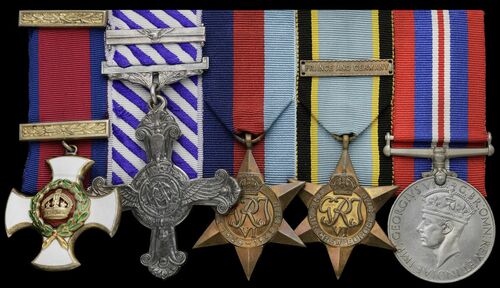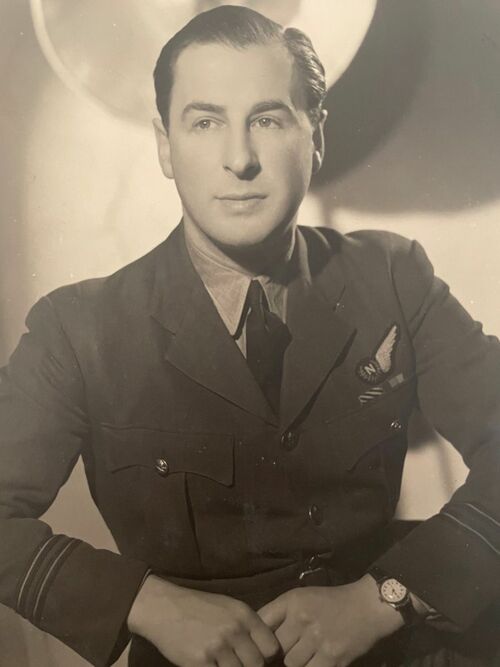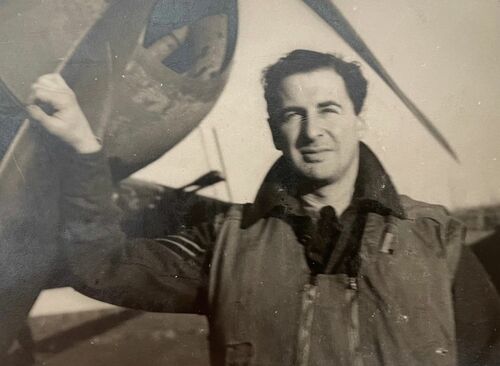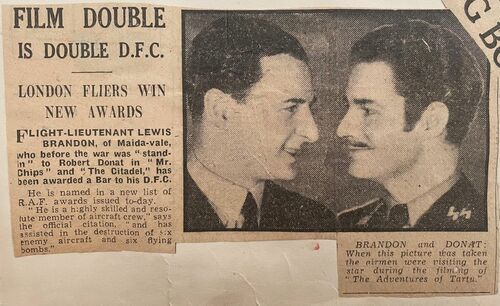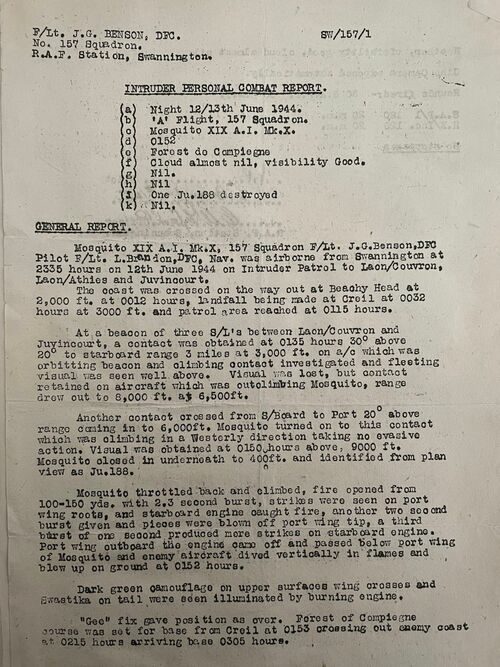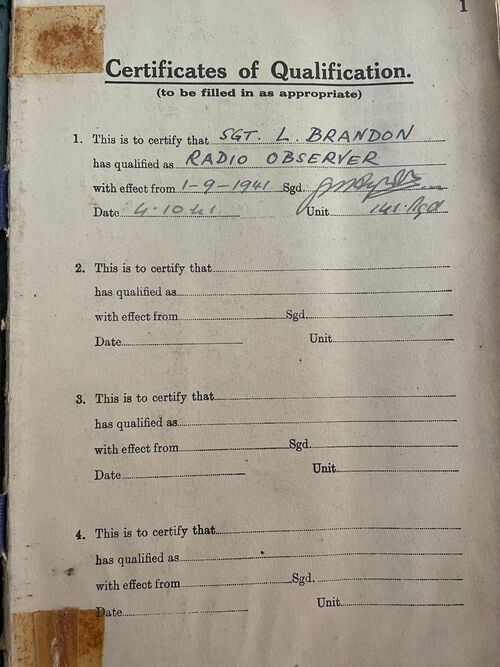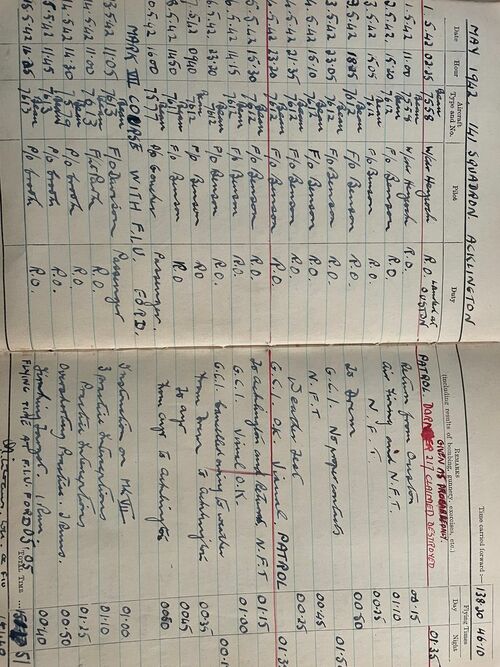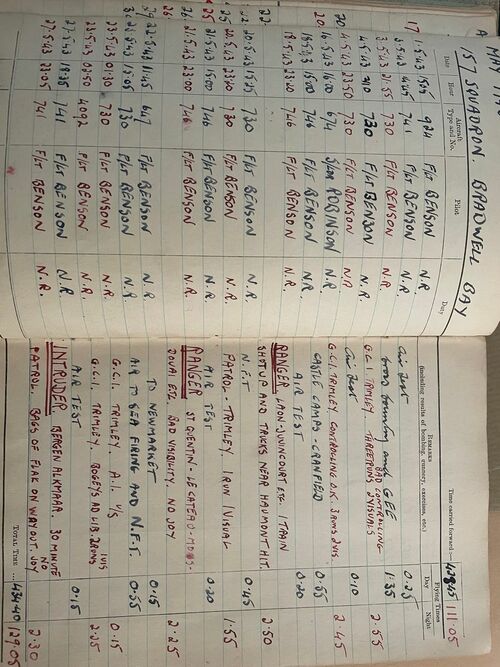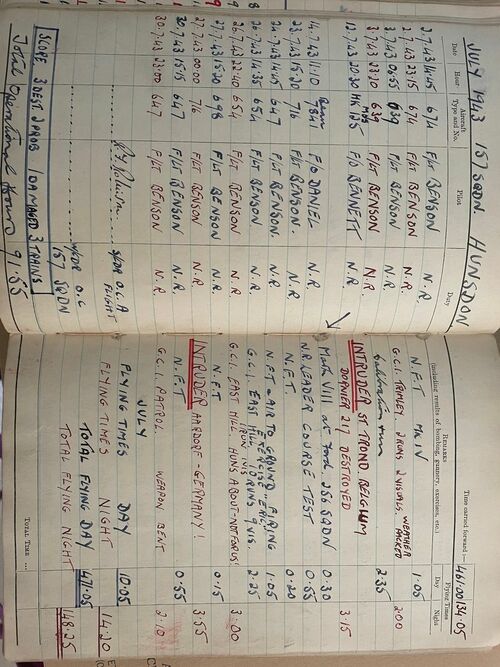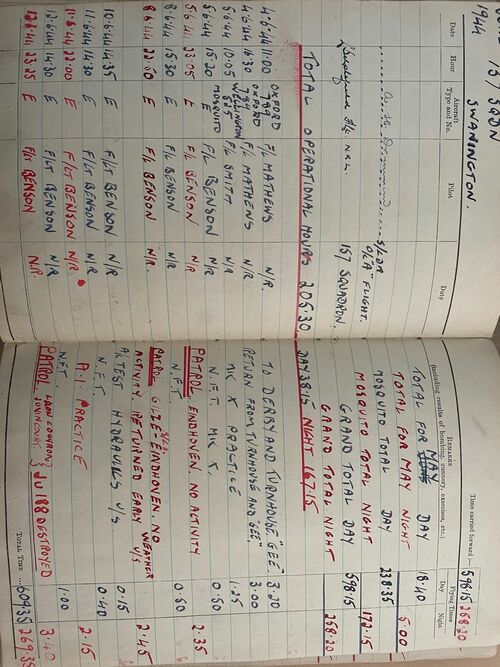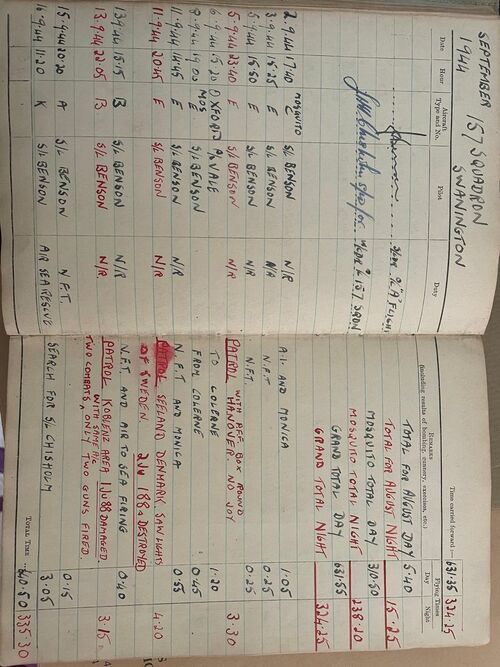Auction: 23001 - Orders, Decorations and Medals
Lot: 401
'As we levelled out, Ben automatically opened the throttles slightly to keep our speed constant. We were closing in perfectly. The blip showed almost dead ahead now.
"Steady now… Range one and a half… We're coming in nicely. Where do you want him?"
"Steady. Put him starboard and above. About ten degrees starboard. What range now?"
"Just under a mile. Throttle back slightly. Can you see anything yet?"
"No, not yet. Keep giving me the range."
About two thousand feet. Gently port now."
A moment's pause, then explosively: "Christ! There it is. It's a bloody great Dornier. Here, have a look. I can hold now."
I needed no urging but swivelled my seat around and peered into the blackness. My eyes took a moment to become accustomed to the dark, then I saw, just above and starboard of us, the vague silhouette of an aircraft with pinpoints of reddish lights showing from the exhausts. I could see the pencil-slim fuselage and the twin fins. It was a Dornier 217, all right. Ben, who by this time was formatting immediately beneath the Dornier and was only 200 or 300 feet below, decided that time for action had arrived.
The Dornier was weaving gently from side to side as it flew along. Ben throttled back very slightly and lifted the nose of the Beau. It was a little over to port now. It seemed strange that it should be completely indifferent to the presence of the Beaufighter so close. As it drifted across in front of us, my heart was thumping so loudly it seemed impossible for the Huns not to hear us. As it passed through his gunsight, Ben turned the Beau almost imperceptibly to follow the Dornier. All hell broke loose as he pressed the gun button and four cannon and six machine-guns banged and clattered away. The Beau filled with the acrid smoke and smell of cordite.
Ben had given it a two-second burst of gunfire; but although the Dornier began to lose height, we had seen no strikes. We did not use tracer bullets at night in order to retain the element of surprise. We were now following it down in a very sharp dive and Ben gave it two more bursts from about 300 feet range. This time there was a great red flash which illuminated the whole aircraft… In the crew room we were just taking off our flying clothing when the ops./telephone rang. It was the Section Controller to congratulate us and tell us the good news that the Royal Observer Corps and Saint Mary's Lighthouse had independently reported a plane crashing into the sea four miles east of Blyth.'
Brandon's "first blood", as recalled in his wartime memoir Night Flyer
The remarkable Second World War night fighter operations D.S.O., D.F.C. and Bar group of five awarded to Squadron Leader L. "Brandy" Brandon, Royal Air Force, late Royal Air Force Volunteer Reserve, a pre-war film actor, and veteran of some 135 operational sorties, who claimed at least 10 confirmed victories as Navigator/Radio Operator to Wing Commander J. G. "Ben" Benson, in addition to taking out half a dozen V.1s, an enduring partnership that placed them in the highest echelons of wartime night fighter aces - and a story related in gripping detail in the recipient's wartime memoir Night Flyer
Distinguished Service Order, G.VI.R., silver-gilt and enamel with top riband bar, the reverse of the suspension bar officially dated '1945'; Distinguished Flying Cross, G.VI.R., the reverse officially dated '1943' and the reverse of the Bar '1944'; 1939-45 Star; Air Crew Europe Star, clasp, France and Germany; War Medal 1939-45, mounted court-style, nearly extremely fine (10)
D.S.O. London Gazette 13 March 1945. The original recommendation - for an immediate award - states:
'On the night of 5 January 1945, this Navigator/Radio Operator assisted his pilot, Squadron Leader Benson, in the destruction of an HE. 219 near Hanover, this being their tenth victim and the Squadron's fiftieth Hun.
During December 1944, this crew flew eight sorties in all kinds of weather and engaged in combat in each of three successive flights. On Christmas Eve they destroyed an Me. 110, and on the previous night probably destroyed a Ju. 88 after chasing it down from 12,000 feet to 800 feet in the circuit of an enemy airfield.
Flight Lieutenant Brandon was awarded a Bar to his D.F.C. in September 1944, after having assisted his pilot in the destruction of two enemy aircraft during one sortie. His score in 100 Group is now six destroyed, one probably destroyed and two damaged. He also co-operated whole-heartedly with his pilot in effectively attacking rail and road transport when airborne targets were not to be found.
Flight Lieutenant Brandon has been Navigator/Radio Operator of No. 157 Squadron since June 1944, during which time the Squadron's score has been raised from 18 to 50 enemy aircraft destroyed. Much of the success that has been achieved is undoubtedly due to Flight Lieutenant Brandon's able guidance and splendid example. In all, he has been on operations for over four years.
His enthusiasm, determination and devotion to duty have been of the very highest order and I recommend him for the immediate award of the D.S.O.'
D.F.C. London Gazette 2 October 1942. The original recommendation states:
'This Radio Operator joined this unit on 1 August 1941 and has since flown as Flying Officer Benson's Operator. He has from the start taken the greatest interest in his work, and has in practice demonstrated his knowledge, skill and quickness in learning the operation of the A.I. set.
It was on the night of 4 June 1942 that he was flying with Flying Officer Benson while operating one of the new sets that form part of the equipment of this Squadron, and while free lancing some distance out to sea that he was able to control his pilot so that two engagements resulted.
Previously he had, again flying with Flying Officer Benson, shared in the destruction of a Do. 217 which was only destroyed by his skill in holding a contact in a steep dive and to a very low height. On another occasion he provided a pilot with orders that produced a visual and an engagement. In fact, he has never lost a contact on an enemy aircraft until his pilot has obtained a visual and an engagement resulted.
His zeal and reliability, together with his four successive chases which have resulted in engagements, mark him as the best Operator in this Squadron, and therefore I recommend that he be awarded the Distinguished Flying Cross.'
Bar to D.F.C. London Gazette 10 November 1944. The original recommendation states:
'This officer completed his first tour in No. 141 Squadron with Squadron Leader Benson (his present pilot), destroying two, probably destroying one, and damaging one enemy aircraft; he gained the D.F.C. in September 1942.
After a rest at an O.T.U., he was posted to No. 157 Squadron in February 1943 where, with Squadron Leader Benson, he took part in operations varying from defensive fighting to night ranging and "Instep" patrols in the Bay of Biscay. He enabled his pilot to destroy two Huns (one over enemy territory), damaged three trains, and to lead his section successfully on long sea patrols. During the latter, Flight Lieutenant Brandon's cool directions on several occasions enabled them to evade very pressing attacks by enemy fighters.
He shows tremendous enthusiasm for the new role of this Squadron which, if success is to be achieved, requires a very high standard of proficiency in a Navigator/Radio Operator.
On his third sortie, he and his pilot destroyed a Ju. 88. On 11 September 1943, after being 'misemployed' for over six weeks on anti-flying bomb patrols, his keenness was rewarded by the destruction of two enemy aircraft over Denmark. On this occasion, contact on the second aircraft was obtained and held before the first had crashed, a remarkable example of coolness and tenacity, the major credit for which must go to the Navigator.
Flight Lieutenant Brandon and his pilot have always insisted on undertaking the longest and most difficult sorties and have set a magnificent example to the rest of the Squadron.'
Lewis "Brandy" Brandon was born Lewis Van Boolen on 11 August 1911, the son of Mark Van Boolen and Rosetta Gottschalk of Sutherland Avenue, Paddington, London. Upon the death of his father on 15 June 1929, Lewis changed his surname to 'Brandon' and spent the following decade working as an extra and stand-in in the film business, prior to enlisting into the Royal Air Force Volunteer Reserve around November 1940. During that period he was selected to double for Robert Donat in a scene for The Ghost Goes West, being retained to work with the trick-camera unit as his stand-in and double on Knight Without Armour, in which Marlene Dietrich played opposite Donat. Brandon was much taken with the exotic and glamorous German-American actress and singer:
'She has something most others haven't got. Her glamour is there however bedraggled she looks.'
Brandon worked in this capacity with a host of stars including Michael Redgrave, Sebastian Shaw and Rex Harrison, before finally receiving his call-up papers whilst serving as a stand-in for Robert Newton on the melodrama Busman's Honeymoon, which was being filmed at Denham Studios in Buckinghamshire. Ordered to report to Cardington in a month's time, Brandon was faced with a 'rest' which he really could not afford; he was therefore all too glad to receive a telephone call from the Casting Department at Denham Studios inviting him to 'earn a few bob' in crowd work for Leslie Howard's upcoming anti-Nazi thriller Pimpernel Smith:
'Half way through the morning the Assistant Director called me…Francis Sullivan, that large and impressive actor, was playing the part of a Gestapo Chief who was a guest at a ball in the British Embassy and it had suddenly been realised that he would not attend such an important function without his aide-de-camp. Nobody had been cast for this part, so I had been roped in.'
It may well be thought that three days would be more than enough time for filming a sequence of this sort, but it was not so. The days went merrily by until Brandon had only three days left before reporting to Cardington. It soon became apparent that the film unit had to finish the sequence with him or would have to re-shoot the entire scene with someone else - a most expensive business. Thus, with the sands of time having run out, it took a very diplomatic call from the production manager to the Adjutant at Cardington to alleviate what was becoming a very pressing situation:
'Using the magic word "Films", I was given a week's leave from the R.A.F. before I had even joined it - to play a Gestapo officer too!'
Transferred from Callington to Bridgnorth for three weeks' square bashing, Brandon was posted to Acklington in Northumberland where he was made to await his turn to go to an Initial Training Wing. He was not much enamoured with the accommodation on offer:
'Our billets had to be seen to be believed. We were in a barn above an inhabited cowshed, about forty of us, with one cold-water tap as the only piece of modern plumbing available for all our needs. It was February, bitterly cold, with plenty of snow around… We of the cowshed were classified as aircraft hands/general duties, an involved way of saying that we were spare bods and could be used for any duty.'
Having endured said conditions, Brandon was sent to the Aircrew Receiving Wing at Stratford-on-Avon. It was here that the Selection Board decided that he was too old for training as a pilot and 'too bulky' to fit into the small turrets used by air gunners. The only job left was that of navigator. In consequence, he was posted to an Initial Training Wing at Scarborough and it was here that he was offered the opportunity to volunteer for flying duties on night fighters:
'The C.O. could tell us very little about the job, but the main points that appealed to me were three in number: it meant a shorter course than the normal navigation course; the pay would be the same; and the volunteers would have to go to the Air Ministry in London for an interview. As I was a Londoner, I did not hesitate at all but decided to try it.'
Having succeeded at interview, Brandon and half a dozen of his contemporaries were sent to Prestwick where No. 3 Radio School was situated. Here they received a three-week course of instruction on the use of 'A.I.' which had been designed by the same brains that had conceived the early-warning radar system of Battle of Britain fame. By enabling a night fighter crew to chase and intercept an enemy aircraft in the dark, the new 'Airborne Interceptor' was small enough to be carried in an aircraft and had the potential to wreak havoc upon an enemy which had switched from daylight attacks to indiscriminate night bombing across the United Kingdom. As one of the first batch of aircrew under training to be instructed in the use of this apparatus, Brandon carried a considerable weight of hope and expectation upon his shoulders; he qualified 'above average' radio observer on 1 August 1941 and joined No. 141 Squadron, a Beaufighter unit of No. 13 (and afterwards No. 11) Group, five days later.
Quite Fearless!
Teamed up with Flying Officer J. G. 'Ben' Benson on 7 October 1941 aboard Beaufighter 7632, Brandon witnessed the first flight of a remarkable wartime pairing that would witness the destruction of ten enemy aircraft at night, in addition to a host of "probables" and damaged. In his own words:
'The outstanding points about Ben were his personality, his power of leadership, his ability to get on with the job in hand and his sense of humour. He was quite fearless, keen as mustard and perfectly unflappable. We both made mistakes but never made the same mistake twice. And our teamwork paid off handsomely when we bagged the first night victory of No. 141 Squadron.'
So, indeed, as quoted above, a Do. 217 south-east of Blyth on the night of 15-16 February 1942, the same month in which Brandon was commissioned. And on the night of 1-2 May, he added a "probable" to his tally, on this occasion with Wing Commander G. F. W. "Pop" Heycock at the helm. Then in early June, back with Benson, he gained two contacts east of the Tyne, resulting in a Do. 217 as a "probable" and another as damaged. Brandon was recommended for the D.F.C. in June 1942, and when the award was announced:
'Some of the London papers mentioned my name and my connection with Robert Donat. I received a telegram of congratulations from Donat, followed by a letter in which he asked me to look him up next time I was in London. He was engaged in making a film, The Adventures of Tartu, at the old Gaumont British studios in Lime Grove - better known now as television studios. I had a forty-eight-hour pass soon after and made a point of going to see him. I spent a very pleasant afternoon at the studios and a publicity still was taken.'
Following a period of rest at an O.T.U., Brandon returned to an operational footing with Benson in No. 157 Squadron, a Mosquito unit, in February 1943, in which capacity he flew numerous "Ranger" and "Instep" operations, in addition to night fighter patrols, once again with notable success - the Squadron's C.O. was Wing Commander V. J. Wheeler, a Great War M.C. and Bar, who added a D.F.C. and Bar to his accolades during the 1939-45 War.
Thus a confirmed Do. 217 on the night of 14-15 April over Layer Breton Heath, near Chichester:
'… At 150 yards I fired a seven second burst and saw strikes first on the port engine and mainplane, which immediately burst into flames. These spread down the port side of the fuselage until the whole aircraft, including the tail was ablaze. There was no return fire. The enemy aircraft went down in a shallow dive turning to port and finally hitting the ground at 0045 hours…'
Three of the crew of the Dornier baled out and were captured; the body of the Wireless Operator was later found in the charred remnants of the wreckage.
Having taken out another Do. 217 over Saint Trond in Belgium on the night of 3-4 July 1943, Brandon transferred in August to No. 488 (N.Z.) Squadron as Squadron Navigator Leader, and flew 39 defensive sorties before returning to No. 157 Squadron from January-May 1944, a period which witnessed several offensive patrols. But it was the Squadron's move to 100 Group that he commenced his most successful period of operations with Benson.
Thus a confirmed Ju. 188 over the Foret de Compeigne on the night of 12-13 June:
'Mosquito throttled back and climbed, fire opened from 100-150 yards, with 2-3 second burst, strikes seen on port wing roots, and starboard engine caught fire, another two second burst given and pieces were blown off port wing tip, a third burst of one second produced more strikes on starboard engine. Port wing outboard the engine came off and passed below the port wing of Mosquito and enemy aircraft dived vertically in flames and blew up on the ground at 0512 hours. Dark green camouflage on upper surfaces, wing crosses and Swastika on tail seen illuminated by burning engine.'
Then on the night of 11-12 September 1944, pilot and radar operator claimed two confirmed Ju. 188s over Zeeland, the second being claimed before the first had even hit the deck, a remarkable feat that resulted in Brandon being recommended for a Bar to his D.F.C. the following day:
'Closed in to 300-400 feet below and after identifying aircraft as Ju. 188 from plan view we throttled back and climbed, opening fire at 150 yards and four second burst. Several strikes seen on fuselage and in starboard wing root. I had to pull over enemy aircraft as we were over-shooting. As we passed over enemy aircraft it fired four star cartridges, two reds and two greens, and passed under us to starboard. We pulled up to port and looked down over the starboard wing for the enemy aircraft.
Observer had another contact ahead on same vector, so we straightened out and at the same time saw enemy aircraft well out to starboard catch fire, and a few seconds later crash on land at 2255 hours, where it was seen burning.
We continued after the second aircraft quite convinced it was a friendly that the first aircraft had been chasing. No such thing. Visual obtained at approximately 1500 feet. Aircraft flying straight and level, closed in below. Identified again as a Ju. 188, flying fast. Observer said: "Make it a flamer". I pulled up the nose and opened fire with a two second burst from 100 yards. Enemy aircraft caught fire in fuselage, pulled up to port, went over the vertical and straight down in flames, exploding with a magnificent flash on hitting sea, at 2302 hours. We flew straight through debris from this aircraft but apart from being thrown about by slipstream, suffered no ill effects'
Once more, the announcement of Brandon's gallantry award hit the home press, the Evening Standard running the headline 'Double D.F.C. for Donat's Double', accompanied by photographs and stories that 'brought about a deal of leg-pulling' from fellow aircrew.
Having then severely damaged a Ju. 88 west of Bonn the following evening, Brandon got another contact on a Ju. 88 on patrol over Frankfurt-Koblenz on the night of 10-11 November 1944, and yet another confirmed victory. In December the intrepid duo claimed Ju. 88s damaged over Wiesbaden on the night of 17-18 and over Neunkirchen on 23rd-24th, Benson reporting on the former occasion 'the excellent work by Flight Lieutenant Brandon, who kept contact despite violent and continuous evasive action of every sort, especially below 2500 feet. The dogfight on A.I. lasted for over 40 minutes.' The very next evening the pair claimed their first confirmed Me. 110:
'Identified as it was crossing from starboard to port as Me. 110 from plain view. Followed visually through two more weaves and then from 150-200 yards at 6000 feet two bursts fired at exhaust pipes. Second burst set port engine and fuselage on fire. Large amount of debris coming back, we dived to port under this and enemy aircraft went to starboard, well on fire. We orbited and enemy aircraft crashed and blew up… About time, too, after two damaged recently.'
Finally, on the night of 5-6 January 1945, they took out an He. 219 over Wesendorf - 'aircraft was seen to crash and explode on the ground in our orbit where it remained burning with ammunition exploding, until we left the position.'
Brandon, who had assisted in downing six V.1s and shooting-up four trains in the same period, was recommended for an immediate D.S.O. on 31 January 1945, so, too, Benson, by which stage the former had amassed nearly 350 hours of operational flying and no less than 135 sorties. And nor were the railway strikes and anti-V.1 sorties any less hazardous than those of the night fighter kind, a case in point being a hectic patrol off the French coast on 27 June 1944, when their Mosquito was very nearly rammed by a flying bomb - and when minutes later they shot another one down, after going into a 320 m.p.h. dive, the resultant stress crushing the nose of that aircraft, 'E' -Eager Beaver.
"Wouldn't one of those do, Sir?"
On learning of their immediate D.S.O.s, Brandon and Benson journeyed into King's Lynn to purchase small lengths of the appropriate ribbon for their uniforms, and, as recounted in Night Flyer, 'entered an establishment that proclaimed itself to be a Military Tailor':
'A young lady came to serve us.
"Do you stock medal ribbons, please?" I asked.
"Certainly, sir," replied the young lady, reaching for a fair-sized box which she opened for our inspection.
There was quite a pretty selection of medal ribbons in the box but no D.S.O. ribbon.
We explained that there was no D.S.O. ribbon in the box and tried to describe what it was like:
"A broad pinky-red band with thinner blue border on either side."
"Just a moment, sir. I'll go and ask."
She returned after a short while.
"No. I'm afraid we haven't anything like that," she said, then, pointing to the box:
"Wouldn't one of those do, sir?" she suggested.'
In company with Benson, Brandon went on to assist forming 1692 Bomber Support Training Wing and, after the War, gained a regular commission in the Royal Air Force. He was finally placed on the Retired List in the rank of Squadron Leader in June 1959. Two years later Brandon published his much acclaimed autobiography Night Flyer, touchingly dedicating the book to his wife Jean and his small daughter Felicity, 'who brought me cups of tea'. The book was full of praise for the service and his comrades, but above all, extolled a deep respect for the Prime Minister:
'This formidable team was so ably led by the only individual that I believe was irreplaceable, Sir Winston Churchill. In the darkest days he provided the inspiration that welded the country into the unified force that was essential for the winning of a modern war. The other leaders, the admirals, the generals and the air marshals, who emerged from the war with great reputations, just happened to be in the right place at the right time. I believe that there were always men who could have replaced them and have done just as well given equal opportunities. There was only one Churchill.'
Brandon spent his later years running a café in Melton Mowbray before moving to Brighton to run the Rex Hotel. In 1965 he moved to a house in Hove and took over as landlord of the Albion Inn. He died in Brighton on 22 April 2002.
Sold with a quantity of original documentation, including:
(i)
The recipient's original R.A.F. Navigator and Air Gunner's Log Books (2), privately bound together, representing the full career of Squadron Leader Brandon, commencing with his first flight aboard a Blenheim Mark I with Pilot Officer Impey on 22 July 1941 and concluding with a flight aboard a Varsity aircraft on 14 January 1954, as part of exercise 'Barrage' flying from Swinderby - The Hague - Cologne - Luxembourg - Amiens - Swinderby. These well-annotated log books offer a fascinating insight into an operational career spanning 902.25 hours of day flying time and 437.30 hours of night flying.
(ii)
A particularly fine wartime scrap book entitled 'Brandy's Line Book' which contains a fascinating archive of wartime documentation and photographs, a hand-written summary of his career, newspaper cuttings and combat reports, including his Buckingham Palace Investiture Letter, dated 14 May 1943, and related admittance ticket, 'Bomber' Harris postagram on the award of his D.S.O., and a letter from the Air Ministry requesting his presence at Buckingham Palace on 29 July 1947.
(iii)
A hardback copy of Night Flyer, R.A.F. Night-Fighters in Action, by Squadron Leader Lewis Brandon, D.S.O., D.F.C., and Bar, printed in 1969; copied recommendations for awards together with private research.
For his miniature dress medals, please see Lot 475.
Subject to 20% VAT on Buyer’s Premium. For more information please view Terms and Conditions for Buyers.
Sold for
£26,000
Starting price
£11000

